Energy Town gains ASE Evaluated status
Introduction

EnergyTown: https://www.wonderverselearning.com/
For learners aged 9-11 and 11-14 years.
The Wonderverse is a STEM learning platform created by science experts and funded by Equinor. As an ASE-accredited resource through the ASE Evaluated Scheme, EnergyTown aligns with ASE’s commitment to promoting excellence in science education. Drawing on real data from the energy sector, the game provides an engaging and scientifically robust learning experience.
The simulation is an engaging and challenging game based on real-world principles of urban planning, sustainability, and resource management. It encourages critical thinking as players build a city using nine or sixteen tiles, ensuring it remains affordable, meets energy needs, respects the environment, and keeps citizens happy.
The EnergyTown game is well supported by additional resources, which comprise:
- Presentations to explain how to play and succeed in the game
- Information about careers in the energy sector
- Quizzes and challenges
- A competition
The game and all resources are free.
Although intended as a game for individuals, there is also great benefit to players working collaboratively in pairs. This brings a whole extra dimension of discussion skills such as questioning, explanation and justification.
Playing the game
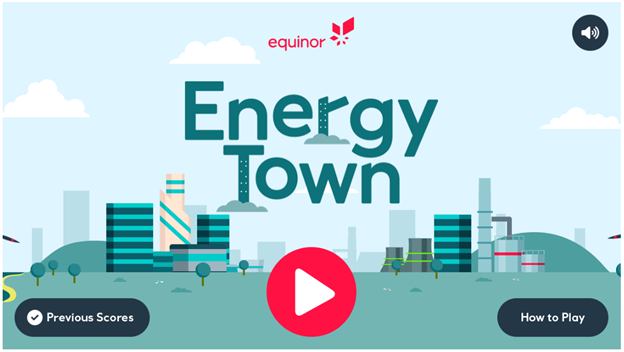
In the first phase of the game, players develop their city by strategically placing tiles on the city grid. The basic level features a 3x3 grid, while the more advanced level challenges players with a 4x4 grid. Players select tiles representing energy resources, housing, businesses recreation, and community areas. For their city to thrive, they need to select a good balance of the different categories of tile. Each tile has a ‘cost’, which is subtracted from the city budget after it is placed. Players continue selecting tiles until the grid is complete, leaving them with a 'working' budget.
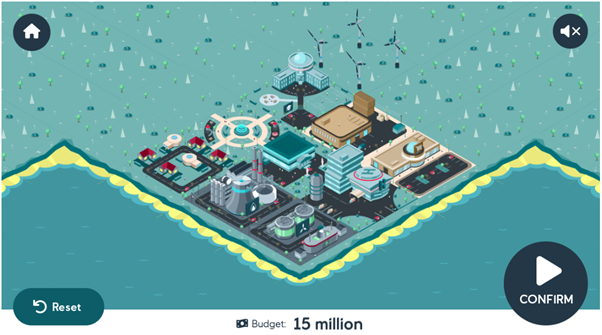
In the second phase of the game, tile choices made during Phase 1 provide ‘scores’ in four categories: ‘Energy’, ‘Money’, ‘Green’ and ‘Happy’. Each tile contributes positively or negatively to the category scores, which are updated during each of 25 rounds of play, taking the player from the year 2025 to 2050. Poor tile choice combinations may well lead to one or more categories reaching zero quite quickly, resulting in ‘game over’. Players are much more likely to succeed if they have paid full attention during the tutorial presentation, and it is worth reminding learners of this!
In each round, players are presented with a ‘decision’ card. For example, choosing to give citizens a ‘longer working day’ has negative consequences for people’s ‘Happiness’ and the ‘Green’ score, but has a positive impact on the ‘Money’ that the city generates. The content of the cards is well chosen, with many providing all-too-common dilemmas similar to those faced by local authorities and national governments alike. Once again, each tile contributes positively or negatively to the overall category scores and the next decision card is presented.
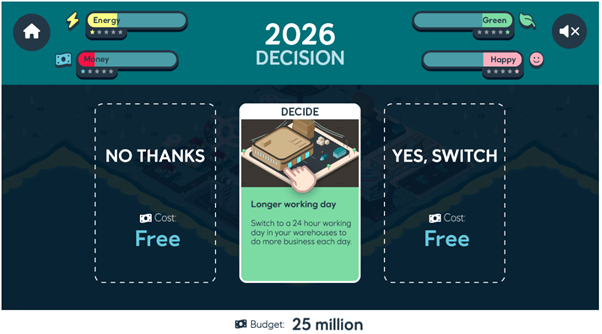
After every five rounds, players are provided with feedback about their city’s progress and are informed of new tiles that they can choose from. For example, a player could exchange their existing gas-fired power station for a nuclear power station, provided they have enough money in their budget, and the nuclear power station tile has been released.
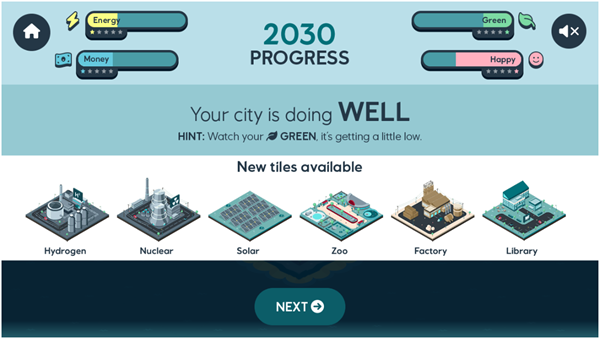
The game continues with additional rounds and feedback every five years. It concludes with a summary slide of overall scores similar to the one shown below:
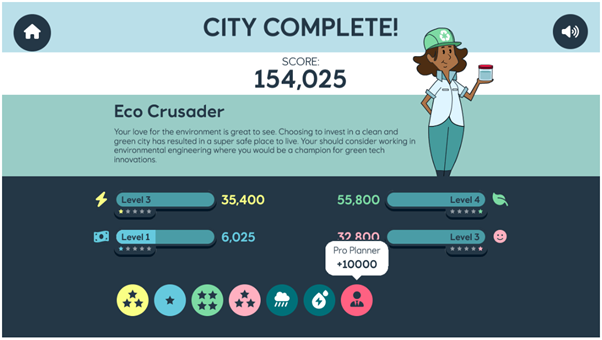
When logged-in, teachers have the option to create a leaderboard for their class or year group. At the end of the game, students can post their high scores onto the leaderboard, by entering the unique ‘key’ provided by their teacher. Teachers may wish to link rewards to this leaderboard.
Supported resources
The game is supported by a suite of resources available to download from the Wonderverse website. Resources are well thought out, well-presented and engaging for learners. Although not required for learners to play the game, the additional activities add extra dimensions to learning, such as careers information and creative thinking activities. There is also a competition that pupils may enter with a prize for the individual and an additional prize for the school – great for enrichment days or even an optional homework activity. There are separate resource bundles for different age groups (9-11 and 11-14).
Primary resources
The game is supported by flexible, pick-and-mix of classroom activities additional to time afforded to playing the game. The table below provides an overview of the resources.
|
Title and suggested time |
Description |
Format |
|---|---|---|
|
How To Play The Game (20 mins) |
A presentation that explains how to play, using screenshots, on-screen explanations and energy industry careers information. Detailed slide notes provide teachers with additional information. |
Presentation |
|
Energy Experts Wanted (20 mins) |
A presentation that explores energy industry careers, culminating in a job application form for children to complete. This resource supports children to learn about energy sector roles and skills through role play and apply their knowledge in an interactive and aspirational way. |
Presentation and PDF form |
|
EnergyTown 2050 Challenge (40 mins) |
A creative challenge encouraging children to imagine life in 2050, considering aspects like living conditions, recreation, energy resources, and the city environment. |
|
|
Energy Resource Match Up (10 mins) |
A card matching activity designed to support language development and reinforce learning from the game, as children explore how energy resources are used as fuels or electricity generation. Extension cards help children identify and match the pros and cons of each energy resource. |
|
|
City Solutions Venn Diagram Challenge (10 mins) |
A presentation to support discussion about planning initiatives. Children play the role of city planner, imagining and discussing the impact of development initiatives on people, the economy and the environment. |
Presentation |
|
What If Challenge Cards (20 mins) |
This series of cards promotes discussion about possible scenarios. For example, ‘What would happen if all electricity was generated by wind turbines?’ The challenge cards are great for supporting scientific thinking, discussion and research skills. |
|
|
Competition Entry Form |
Details of how to enter the 2025 ‘City Innovators’ challenge: A competition to win a £1000 science grant for your school and tablets for individual winners. |
|
|
Teacher Guide |
The teacher guide includes an overview of the resources, how they can be used and curriculum links. |
|
Secondary resources
The game is supported by flexible, pick-and-mix of classroom activities additional to time afforded to playing the game. The table below provides an overview of the resources.
|
Title and suggested time |
Description |
Format |
|---|---|---|
|
How To Play The Game (20 mins) |
A presentation that explains how to play, using screenshots, on-screen explanations and energy industry careers information. Detailed slide notes provide teachers with additional information. |
Presentation |
|
My EnergyTown 2050 (40 mins) |
A research and reporting activity for students to discover new ideas and innovations for generating electricity from sustainable energy resources. |
|
|
Energy Resources Quiz (10 mins) |
A quick-fire quiz to support testing students’ knowledge relating to renewable and non-renewable energy resources. |
Presentation |
|
City Survivor Worksheet (10 mins) |
An activity for students to explore the consequences of energy decisions, depending on factors like fuel shortages and political decisions. |
|
|
Energy Battle Cards (20 mins) |
An interactive card game for students to compare energy resources. |
|
|
Transition To Renewable Energy Resources (20 mins) |
Students analyse data to explore energy mix trends over time. By examining countries’ shifts to renewables they predict future trends. |
Presentation |
|
Competition Entry Form |
Details of how to enter the 2025 ‘City Innovators’ challenge: A competition to win a £1000 science grant for your school and tablets for individual winners. |
|
|
Teacher Guide |
The teacher guide includes an overview of the resources, how they can be used and curriculum links. |
|
Conclusions
The EnergyTown resource takes a multi-layered approach, helping players recognise that energy provision is not a straightforward process. They learn to assess cost-benefit trade-offs and make decisions based on priorities such as happiness, the environment, or energy security.
EnergyTown supports motivational learning through gamification and is grounded in robust science principles. It’s a valuable extension and enrichment activity that highlights practical applications to core learning and develops scientific thinking skills.
